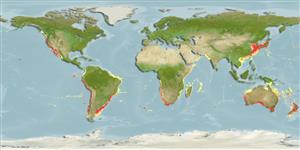Elasmobranchii (sharks and rays) >
Hexanchiformes (Frill and cow sharks) >
Hexanchidae (Cow sharks)
Etymology: Notorynchus: Greek, noton = back + Greek, rhyngchos = snout (Ref. 45335); cepedianus: maculatus meaning spotted (Ref. 6885).
Environment / Climate / Range
Ecology
Marine; brackish; demersal; depth range 0 - 570 m (Ref. 26346), usually ? - 80 m (Ref. 5578). Subtropical, preferred 17°C (Ref. 107945); 56°N - 55°S, 131°W - 177°E (Ref. 54680)
Circumglobal: In tropical to temperate waters; except North Atlantic and Mediterranean Sea. Southwest Atlantic: southern Brazil to northern Argentina. Southeast Atlantic: Namibia to East London, South Africa (Ref. 5578). Western Pacific: southern Japan to New Zealand. Eastern Pacific: British Columbia, Canada to Chile. Record from India maybe erroneous.
Length at first maturity / Size / Weight / Age
Maturity: Lm ?, range 192 - 208 cm
Max length : 300 cm TL male/unsexed; (Ref. 5578); common length : 150 cm TL male/unsexed; (Ref. 6077); max. published weight: 107.0 kg (Ref. 9987); max. reported age: 49 years (Ref. 27952)
Dorsal
spines
(total): 0;
Dorsal
soft rays
(total): 0;
Anal
spines: 0;
Anal
soft rays: 0;
Vertebrae: 123 - 157. A large seven-gilled cowshark (Ref. 5578) with a wide head, short and blunt snout, and fusiform body. Dorsal fin small, origin may vary from over insertion of pelvic fins to over free rear tips of pelvic fins. Anal fin smaller than dorsal fin. Tooth count 15-16/13. Reddish-brown to silvery-grey or olive-brown with numerous small black spots on body and fins; cream below (Ref. 5578).
Found on the continental shelf, often in shallow water (Ref. 247). Occurs close inshore, in bays and estuaries (Ref. 6871), with larger individuals ranging into deeper waters offshore and deep channels in bays (Ref. 247). Usually cruising steadily and slowly near the bottom (sometimes in water as shallow as a meter), but sometimes at the surface (Ref. 247). Can dash at speed when attacking prey (Ref. 247). Feeds on anything, including other sharks, rays, chimaeras, bony fish, hagfish, dolphin and porpoise meat, seals, shark egg cases, sea snails and mammalian carrion, including rats and humans (Ref. 5578). Ovoviviparous (Ref. 50449), with 82 to 95 young in a litter (Ref. 31395). Aggressive when provoked, and regarded as potentially dangerous to people in open waters (Ref. 247). It has attacked divers in captivity and may be involved in a few shark attacks off California and South Africa (Ref. 247). Often caught by anglers from the shore (Ref. 6574). Utilized for human consumption, its skin for leather, and its liver as a source of oil (Ref. 247).
Ovoviviparous, embryos feeding solely on yolk (Ref. 50449), with number of young reaching 82 in a litter. Gravid females apparently drop their young in shallow bays. Size at birth between 40 (Ref. 26346) and 53 (Ref. 247) cm. Distinct pairing with embrace (Ref. 205). Gestation period 12 months. The reproductive cycle appears to be biennial (Ref. 45445).
Compagno, L.J.V., 1984. FAO Species Catalogue. Vol. 4. Sharks of the world. An annotated and illustrated catalogue of shark species known to date. Part 1 - Hexanchiformes to Lamniformes. FAO Fish. Synop. 125(4/1):1-249. Rome, FAO. (Ref. 247)
IUCN Red List Status (Ref. 115185)
CITES (Ref. 94142)
Not Evaluated
Human uses
Fisheries: commercial; gamefish: yes; aquarium: public aquariums
Tools
Special reports
Download XML
Internet sources
